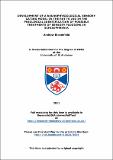Files in this item
Development of a neurophysiological sensory gating model in the rat to aid in the preclinical identification of possible treatments of sensory flooding in schizophrenia
Item metadata
| dc.contributor.advisor | Bowman, Eric MacDonald | |
| dc.contributor.author | Bloomfield, Andrew | |
| dc.coverage.spatial | 44 | en_US |
| dc.date.accessioned | 2013-06-04T15:40:24Z | |
| dc.date.available | 2013-06-04T15:40:24Z | |
| dc.date.issued | 2011 | |
| dc.identifier.uri | https://hdl.handle.net/10023/3604 | |
| dc.description.abstract | Objective: It has been widely hypothesized that a failure to properly filter, or ‘gate’, incoming auditory information occurs in schizophrenic patients. This can be observed in a reduced event-related potential response to the second of a pair of clicks, and this is referred to as P50 suppression after the name of the component that is attenuated to the second click. Our aim was to develop a model of gating failure in rats by measuring event-related potentials at different intervals between the clicks to validate that apparent gating in rats looks like P50 suppression in humans. We also sought to determine the relationship between two of the most commonly used assays of auditory gating: the mismatch negativity (an event-related potential evoked when a series of standard tones is followed by a deviant or oddball tone) and neurophysiological suppression in the double-click paradigm. Methods: Male outbred Lister Hooded rats (N=8) were tested using electrophysiology to record P50-like event-related potentials (ERPs) to assess the overall competence of the rats' sensory gating. The rat N40 potential, thought to be equivalent to the human P50 potential, was measured after each of two 85-dBZ paired (conditioning and test) 0.1msec duration clicks separated by inter-stimulus intervals of 250msec, 500msec, 1000msec, and 2000msec presented at 10second inter-trial intervals. If the N40 potentials are similar to the human P50, then the magnitude of the potential of the second click should be attenuated (a measure of gating of the repetitive stimulus). Additionally, we were interested in whether the suppression of the rat N40 to the second click was similar to the suppression of the human P50 in being vulnerable to disruption by amphetamine. We measured N40 suppression in four conditions: pre-drug, after saline injection, after 6 dextroamphetamine injection, and post-drug. Finally, we correlated the N40suppression with another neurophysiological measure of gating, the mismatch negativity. Results: We determined that as the inter-stimulus interval increased in duration, the degree of N40 suppression decreased linearly. The administration of d-amphetamine had a non-significant effect, although our results indicate that further testing with a slightly larger sample size would be relevant. Finally, the relationship between the MMN and N40 suppression was weak, which is similar to the relationship between the human P50 suppression and mismatch negativity. Conclusions: These data are a relevant initial step towards a neurophysiological sensory gating model to aid in preclinical identification of possible treatments of sensory flooding in schizophrenia. The characteristics of the rat N40 suppression match those of the human P50 suppression with the apparent exception of vulnerability to disruption by amphetamine. | en_US |
| dc.language.iso | en | en_US |
| dc.publisher | University of St Andrews | |
| dc.subject.lcc | RF294.5E87B6 | |
| dc.subject.lcsh | Auditory evoked response--Physiological aspects | en_US |
| dc.subject.lcsh | Auditory evoked response--Testing | en_US |
| dc.subject.lcsh | Sensory disorders | en_US |
| dc.subject.lcsh | Schizophrenia--Physiological aspects | en_US |
| dc.title | Development of a neurophysiological sensory gating model in the rat to aid in the preclinical identification of possible treatments of sensory flooding in schizophrenia | en_US |
| dc.type | Thesis | en_US |
| dc.type.qualificationlevel | Doctoral | en_US |
| dc.type.qualificationname | MPhil Master of Philosophy | en_US |
| dc.publisher.institution | The University of St Andrews | en_US |
This item appears in the following Collection(s)
Items in the St Andrews Research Repository are protected by copyright, with all rights reserved, unless otherwise indicated.

